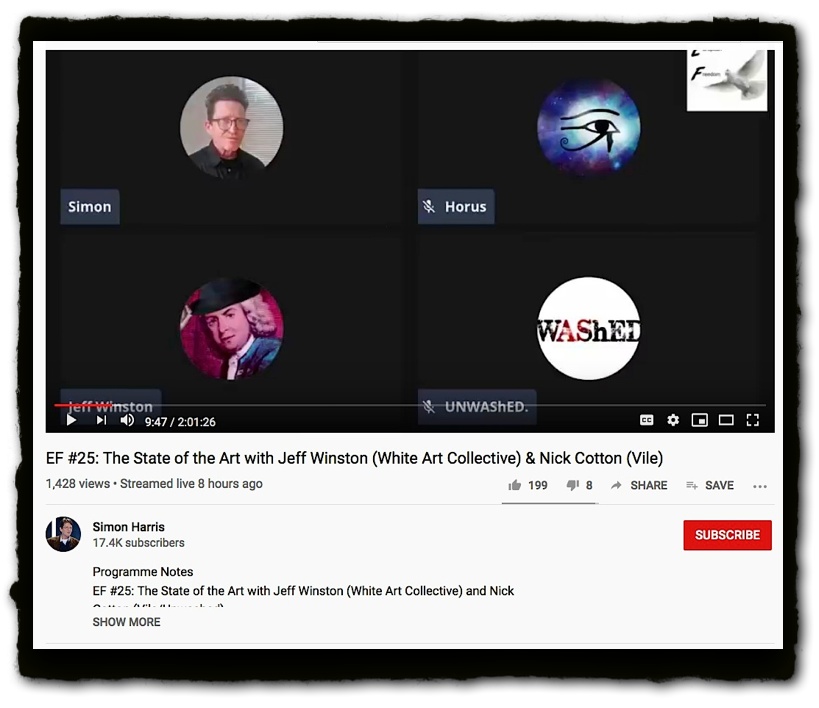 [Morgoth reviews a section of Edward Bernays’ book “Crystallizing Public Opinion” where Bernays discusses the methods to manipulate established public opinion, where he used them to successfully convert the female population to take up smoking. Morgoth suggests that the same methods can be used by the dissident Right to bring more people to our side.
[Morgoth reviews a section of Edward Bernays’ book “Crystallizing Public Opinion” where Bernays discusses the methods to manipulate established public opinion, where he used them to successfully convert the female population to take up smoking. Morgoth suggests that the same methods can be used by the dissident Right to bring more people to our side.
— KATANA]
Morgoth’s Review
Edward Bernays
The Group and the Herd
Jul 1, 2020
Click here for the video:
https://www.youtube.com/watch?v=2PwIIunMDhE
Published on Jul 1, 2020
YouTube Description
31.7K subscribers
Buy me a pint here
https://www.subscribestar.com/morgoth…
https://www.patreon.com/Morgoth
https://ko-fi.com/K3K3RSEG
Bitchute
https://www.bitchute.com/channel/morg…
Thanks to Theberton for the intros and outros
TRANSCRIPT
(21:13)
[00:00]
[Intro music and imagery by Theberton.]
[00:24]
Hello there folks. On a recent video, the Civilization one, I took a look at history through the prism of technology. That technology was the driving force of history. Played around with that idea and took away a lot of where that’s going to lead us, where it is leading us. And in that I kind of side-lined the idea that there’s people pulling strings and manipulating people according to a certain plan, and that kind of thing.
And I wanted sort of go right back in that direction on this one. And look at, in this case it’s a book I’ve been reading by Edward Bernays. So Edward Bernays is the nephew of Sigmund Freud, similar ((((heritage))), of course, and he has a few books, which I’ve been reading his one called “Crystallizing Public Opinion”.
And Bernays went from Austria to America, and once he got there he began to apply the thinking of Sigmund Freud psychology, of course, psychoanalysis. And Bernays wasn’t interested in it at the individual level, so much as he was in mass manipulation. How you can use psychoanalysis and psychology to play on the fears and manipulate the masses. And he’s written some books about it. And one of them which I’m reading is called “Crystallizing Public Opinion”. In particular, Part Two, which is called “The Group and the Herd”. And Chapter One, “What Constitutes Public Opinion”.
So people may know of Bernays from Adam Curtis documentary, “Century of the Self”, which is a brilliant documentary. But Curtis’ documentary is looking at how Capital did this, how they molded the public and public perception. It touches on the Frankfurt School.
But Bernie’s runs alongside of that. Obviously similar background, but he’s not coming at it from the neo-Marxist, or whatever you want to call, side of it. It’s about psychology. But the effects of it on discourse, and on the West, beginning with America, are very similar.
So the problem that what Bernays is going to do here is look for ways at the public and the opinions of a public and how they view the world can be manipulated. And he ended up working for cigarette companies, big money. And then eventually what you could call like the sort of the “proto-deep state”. So and in his book “Crystallizing Public Opinion” and the other one which is just called “Propaganda”, he’s really like straight out saying like:
“This is what we do!”
It’s really surprising just reading how balls-out it is, how in your face it is! He’s not trying to hide anything.
But what I found interesting about the chapter “What Constitutes Public Opinion” is that Bernays is going to approach the problem of how you manipulate the masses. And he’s going to raise a few issues, which I think can resonate with people in dissident Right circles today. Because I think that when you mention somebody like Bernays, or you mentioned people like Horkheimer, Adorno, there’s this knee-jerk reaction to, sort of, they’re just like bogeyman! And there’s too few people looking into the text that what it is they’re actually saying. And I like this idea of demystifying them and their ideas. And in some cases they’re actually approaching problems which people in the dissident Right are focused with.
And you can see it with Bernays straight away, because the problem that he’s, what I find interesting in this chapter, is he’s gonna come up with a problem that if you want to, let’s say from his perspective it would be to red pill the masses. But the problem that he comes up against is that the masses have already been programmed. Somebody’s already been there and done it. And he says they’re getting their opinions from the radio at this time, from the newspapers, from the church, from the schools. And so, they’ve got this “deadwood” that needs to be cleared away. And he wants to figure out how that can be done. And he’s gonna play around with a lot of ideas here.
[05:00]
But what’s interesting is that you can see here this idea that we’re all rational liberals. And that we all form our opinions based on our own reason, is actually complete rubbish! He doesn’t believe that at all! And he sees it again, and again, and again! And so for an example there’s this part where he says:
“The religious man accuses the atheist of being shallow and irrational, and is met by a similar reply. To the Conservative, the amazing thing about the Liberal is his incapacity to see reason and accept the only possible solution of public problems. Examination reveals the fact that the differences are not due to the commission of the mere mechanical fallacies of logic, since these are easily avoided, even by the politician. And since there is no reason to believe that one party in such controversies is less logical than the other.”
And so what he means is that people already have their own preconceptions and their own biases about the world that they’ve already been programmed, and that you can’t talk them out of them.
Now this is something that’s going to resonate with a lot of people who watch this video, because we run up against this every day. We talk about how do you red pill normies, how do you red pill the masses, how do you convince them of our opinions? And again, and again, we come back to the problem that they’ve already had another set of ideas, and another set of biases, handed to them by the media. It’s just the media today is much more sophisticated than in Bernays’ time.
But nevertheless he’s still touching on something, which is very similar. And he goes on to say:
“The difference is due rather to the fundamental assumptions of the antagonists being hostile, and these assumptions are derived from herd-suggestions.”
Now as I showed in the title he again, again, and again, throughout what I’ve been reading by him, he’s got nothing but contempt for the masses, and he literally calls them “a herd”. And it’s about how you manipulate the herd. And there’s a famous passage somewhere where he says:
“All of your opinions and what you think of as your take on the world, is literally being written elsewhere by people that you’ve never heard of!”
And it’s as if Bernays wants to get in on the action. And he is actually hired to do this. But we’re going to get into an example of that later, and the most famous one, of course, now:
“To the Liberal certain basic conceptions have acquired the quality of instinctive truth, have become a priori syntheses, because of the accumulated suggestions to which he has been exposed; and a similar explanation applies to the atheist, the Christian, and the Conservative. Each, it is important to remember, finds in consequence the rationality of his position flawless and is quite incapable of detecting in it the fallacies which are obvious to his opponent, to whom that particular series of assumptions has not been rendered acceptable by herd suggestion.”
So what he’s getting at here is that if you think that the basic standard — in Britain that would be the Conservative voter and then the Liberal, the Labour voter — they both have their own fundamental truths and it’s handed to them by the media that they consume, by the church, or in the Left it would be the University, and then so on. So they are forming their opinions and then they belong to a herd, and then that herd reinforces all of those opinions. And even when you show them something, which is flat-out wrong, they will merely sort of fall back on, and draw from their own sources, to create the narrative all of their own.
And so Bernays is interested, because he needs to change this. So, at this point, he is faced with the same problem that dissident people do. And he goes on:
“Thus the public relations counsel, …”
He’s talking about basically being the deep state, the public relations counsel, as he calls it. There’s this kind of interconnection between the American government and big money, as there is today. Much more so today, in fact, largely based on some of the ideas that Bernays got into. So this:
“Public relations counsel has to consider that a priori judgment of any public he deals with before counseling any step that would modify those things in which the public has an established belief.”
So what he’s saying here is that when you hit them directly with counter evidence, facts which run against the grain of their narrative, they just reject them. This is the problem that he’s facing.:
“It is seldom effective to call names, or to attempt to discredit the beliefs themselves. The counsel on public relations, after examination of the sources of established beliefs, must either discredit the old authorities, or create new authorities by making articulate a mass opinion against the old belief, or in favor of the new, … The average citizen is the world’s most efficient censor. His own mind is the greatest barrier between him and the facts. His own ‘logic-proof compartments,’ his own absolutism, are the obstacles which prevent him from seeing in terms of experience and thought rather than in terms of the group.”
[10:46]
So, what Bernays is saying here, is that when you’re directly antagonistic to these people, if you just, obviously as he says, calls them names, or if you just trash their arguments outright, it isn’t actually very productive.
What you do instead — there’s two parts to this — there’s, you have to speak from authority, which is nigh on impossible. But, if you get a large enough presence on social media, or you form your own political party, you can reframe these things where you’re speaking to somebody’s gut instincts, rather than just being negative.
And the second part of that, is that you don’t antagonize them. And so you’re speaking from authority. And then the second part is that you give them a new narrative upon which they can not trash their old opinions, that will come later, instead what you’re doing is supplanting one narrative, one worldview, with your own.
And this is what Bernays perfected. This is what’s being done so successfully in the West. And you can see it just in the riots and all of the trouble going on for the last few months. And as I’ve said, like ad nauseam on this channel, to be honest, it’s all backed up by all of these PR companies, advertising agencies. You can see how it all links together. It’s just that it’s much more sophisticated now than in Bernays’ time. But here’s the man who is widely regarded to have come up with it all. And he’s got some very interesting books about it.
So, what he’s most famous for is the cigarette advertising campaign, where he was hired by a few different companies. And the problem that they had was that women in America, it was considered taboo for women in America to smoke cigarettes. Now this is a problem, because it means that essentially that big business have lost half of the potential buyers of cigarettes, which is a hell of a lot of money! And they hired Bernays to come up with PR campaigns and advertising techniques, where they could get women smoking.
And so just to go back on the earlier point that he was making there, the one thing that you could do is to hit the taboos dead on. But that would antagonize them. So, he’s gonna use his own techniques here. And eventually what he came up with this idea. If you look at all of the — on Google Images as I did — all of the pictures, the advertisements being used of women, are just women with a cigarette. And the “torches of freedom” as they called it.
The women in the advertisements, they don’t have a husband there, or a man. They don’t have a father figure. They aren’t portrayed as daughters, and they don’t have children. There’s just the women! Just a woman. And the narrative which is being given to them is that they are now “free”! They are now “liberated” and it’s a positive vision, something for them to aspire to.
And I’ll describe this Wikipedia page:
“Because it should appear as, …”
This is Bernays:
“Because it should appear as news with no division of the publicity, actresses should be definitely out.”
He wants to make this look normal:
“On the other hand, if young women who stand for feminism someone from the Woman’s Party say — could be secured, the fact that the movement would be advertised too, would not be bad, … While they should be good-looking, they should not be too ‘model-y’. Three for each church covered should be sufficient. Of course, they are not to smoke, simply as they come down the church steps. They are to join in the Easter Parade, puffing away.”
So it’s not to be connected with the traditional family, because that’s the old narrative. He doesn’t want to hit it straight on. Instead, he’s creating a NEW vision and a NEW image and it will be of the woman alone, liberated from men! The feminist movement is just coming in here. You see that big business, big capital, is absolutely on board with what would be perceived as being a left-wing movement, a feminist movement! And you can see that they complement each other perfectly.
And that the image of the woman with a cigarette is kind of like a crypto, proto-feminist image. And yet, it’s coming from big capital.
[15:32]
This leaves us onto something else, because it’s been a hot topic recently in dissident Right circles where people have been much more vocal in attacking big money, big capitalism, because it was standard to say, well, lay all of this squarely at the foot of Marxism. And then to say the end result will be that we all live in, … Basically they’re going to deconstruct everything about Western civilization, all of our norms, all of our traditions, and they will then bring in the Communist revolution.
And yet here we have Bernays, and as I say, in literature, and so on, he often runs alongside the Frankfurt School. He has the same (((heritage))) and he is a kind of a foreigner to America. And that means he can stand outside of the normal cultural fabric and attack it, and undermine it, and study it, from that perspective, which is more difficult if you’re a native and you’re submerged in it.
But you can see here that the problem is that big money, big capital, employed him to subvert the values, just in the cigarette advertisements here. There was more. And I think I’m gonna do more videos on this, as well. I just want to focus on this little part here.
You can see here that it was corporations who hired him to study how you can then begin to break down these more conservative, more traditional, values and all of that they can open up what was then half of the market of America, which was women. And needless to say, tens of millions of women will have died of lung cancer, because of this. And Bernays himself was adamantly opposed to smoking and I didn’t want his wife to smoke either. But later on in his life he did get on board the anti-smoking thing.
But the point here is that this is a cultural value, a cultural more which was a good one, and it was a healthy one. And it was abolished. And feminism went alongside big money here. So we have to have a closer look at the role that big capital, high finance, has played in the current state of the West today. And it triggers a lot of people, because you’re going to be called a Marxist, you’re gonna be called, you know, you’re just a communist. But nevertheless we have here a clear example of capital hiring somebody to break down the mores and values, to open up markets.
And we can see this happening again, and again, and again, in fact. Mass immigration will be another one.
But just to get back to the basic narrative which is an interesting one for this particular chapter here. When we get into the how we kind of confront people, if you want to use Bernays, or if you’re in a dissident movement, you can whittle his advice down to three different points.
And it’s number one, don’t antagonize. Number two, replace the source. And, three, use the source to replace the narrative.
So you have to get into a position where you can dish out your narrative. You do not have to be completely antagonistic to everybody else around you. It’s actually why I find debates to be a waste of time, because it’s exactly what Bernays is talking about with the sort of Left-Right dichotomy. Everybody is just gonna dig in to their own trenches. You’re not going to get anywhere. If you opened up a third trench, a “third position”, you might say.
But when you’re deliberately antagonistic all it does is reinforce people’s beliefs and they’re going to get on the defensive. You replace the source, obviously, so you you can peddle your narrative.
And then instead of being completely antagonistic, you just replace the narrative, you know, with your own, which is followed by words that are positive, or speaking some sort of fundamental truth. And then you’ll find that people from elsewhere will move towards you.
This is an interesting way to look at this, in how you manage the masses. But what’s most interesting is that you can get rid of all of these liberal preconceptions that all of the people, all of the normies, have all arrived at their positions through their own reason. It’s not the case.
And the people who control the discourse, the people who control the culture, and set the running here, they know it as well! The only people who think they’ve arrived at their own opinions, that we live in this society where everybody is rational, and everybody has come to their understanding of the world through their own volition, is completely deluded!
And when we can just step over these false preconceptions about the world we might actually get somewhere.
So I think I’m gonna carry on reading this and do another video, because I think we need more stuff like this.
So, thanks for listening folks, and I’ll catch you later.
[20:57]
[Outro music and imagery by Theberton.]
[21:13]
END
============================================
============================================
See Also
Millennium Woes with Morgoth on Brexit — TRANSCRIPT
Millennial Woes’ Millenniyule 2017 No. 66 – Morgoth — TRANSCRIPT
Morgoth’s Review – YouTube Hangout 01 – Skeptics and Cucks — TRANSCRIPT
Morgoth’s Review – YouTube Hangout 02 – Merry Holocaustmas — TRANSCRIPT
Morgoth’s Review — The Psychotic Left, Feb 2019 — TRANSCRIPT
Morgoth’s Review – Fishing For White Pills, Feb 2019 — TRANSCRIPT
Morgoth’s Review – Hope Not Hate and the State of Play, Feb 2019 — TRANSCRIPT
============================================
PDF Notes
* Total words = 3,308
* Total images = 16
* Total A4 pages = xx
Click to download a PDF of this post (x.x MB):
(Available later)
Version History
Version 4:
Version 3:
Version 2:
Version 1: Jul 5, 2020 — Published post.






















































